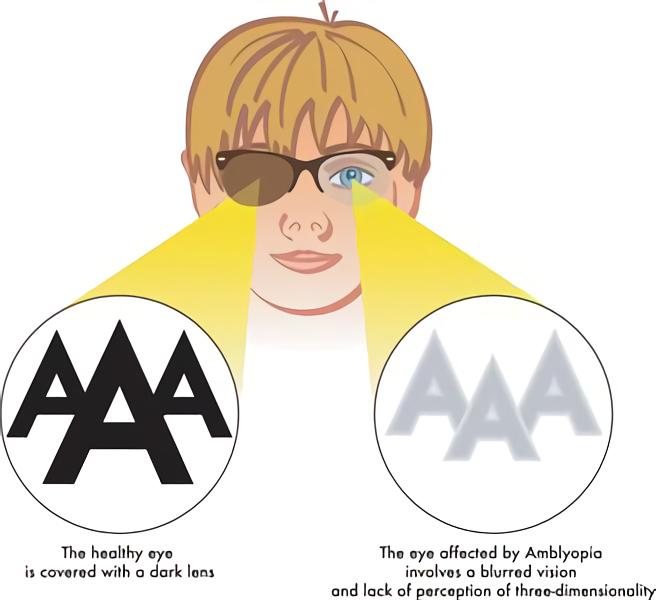Share This Article
Do you suspect your child or someone you knows has what’s often referred to as a Lazy Eye? In which case, they likely have amblyopia, which is a common condition that usually affects one eye and is particularly found in children. When you look at the dictionary, amblyopia definition is “reduced vision typically in one eye that results from the brain suppressing input from the affected eye due to unmatched visual signalling from each eye leading to inadequate development of visual accuracy in the problematic eye. On occasion, the misalignment results in double vision.”
Why Does Amblyopia Occur?
It occurs when there’s a miscommunication between the brain and the eye. The brain doesn’t recognize sight from one eye, so it relies on the other eye – which is stronger. The result is that the eye that doesn’t work as well becomes lazy and the vision deteriorates. Of course, it doesn’t mean that the person suffering with amblyopia is lazy, it’s just that the eye appears slower.
The condition occurs during childhood and if left untreated, can result in loss of vision. Statistics tell us that approximately three in 100 children suffer with amblyopia but with early intervention, it is treatable, and eyesight should rectify itself, preventing long-term vision problems.
Refractive Amblyopia
You may hear your doctor use the term refractive amblyopia, which is still a lazy eye. This is the most common type of amblyopia and happens when a child is born with blurred vision in one eye although both eyes are perfectly in line with each other. One eye might be short-sighted whereas the other might be normal or one eye might be long-sighted and the other has 20-20 vision. It also occurs when one eye has an astigmatism. It happens because the pathways of the nerve at the back of the eye between the retina and the brain experiences a nerve change, so the weaker eye receives fewer visual signals. Left untreated, vision worsens, and the brain doesn’t pay any attention to the weaker eye.
The Symptoms of Amblyopia

At first, you may not notice a lazy eye but children suffering with the condition will have poor perception of depth meaning they can’t decipher how near something is, or how far. Other symptoms include:
- Closing one eye.
- Squinting to see something.
- Head tilting.
Usually amblyopia is detected during an eye examination which is why it’s essential that all children have an eye test between the age of 3 and 5 years old.
Who Is More at Risk of Amblyopia?
There are some children who are more at risk of amblyopia. Some children are born with it whereas others develop amblyopia later on. The risk is higher in children that were born premature, had a smaller than average weight at birth, have family history of eye problems such as lazy eye, cataracts, or other condition and also those with developmental issues.
Amblyopia Definition – the Causes
Often, it is difficult to assess the cause but sometimes, different vision problems can result in a lazy eye. The brain uses nerve signals telling the eyes to see something but when vision is worse in one eye, the brain adjusts itself to send stronger signals to that eye and even switches signals to the other eye off. There are other conditions that lead to amblyopia such as:
- One amblyopia definition is determined by refractive mistakes, this includes short-sighted (where you cannot see distant objects), long-sighted (where you cannot see objects close-up) and astigmatism (which is a blurred vision). Glasses and contact lenses can correct these vision problems but if left untreated, the brain will begin to rely on the better eye.
- Strabismus, this is when eyes don’t line up and one eye moves upwards, outwards, or downwards.
- Cataracts, this is when the eye’s lens becomes cloudy, so vision is blurred. Usually, cataracts occur as a result of the aging process, but children and even babies can develop cataracts.
Here you can check about Diabetic Retinopathy too.
Checking for Amblyopia
Your child’s doctor or eye specialist will conduct a visual screening to look for the signs. All children aged between 3 and 5 should be checked as a matter of precaution. You can read more about the symptoms, checking the definition of amblyopia and treatment here: https://kidshealth.org/en/parents/amblyopia.html
Treatment for Amblyopia
If it’s a vision problem, then that will be treated first, it might just be that glasses or contact lenses are required. As well as glasses or contact lenses, your child might need to have his or her brain re-trained to strengthen signals to the weaker eye. Treatment for this includes wearing an eye patch on the better eye. The eye is covered with an eye patch forcing the brain to send signals to the weaker eye. Often, a child will only need to wear an eye patch for a couple of hours daily but in extreme cases, a child may have to wear an eye patch all day.
Another treatment for amblyopia is eye-drops, using atropine, a special drug that blurs near vision in the good eye, forcing the brain to switch to the weaker eye. This often works as well as using an eye patch and is usually a better option as it’s easier than wearing an eye patch. Lots of young children remove their eye patches!
Following treatment, the child’s vision normally improves within a matter of weeks, but the best results take a little longer, usually a few months. Occasionally, you might need to continue treatment to prevent a lazy eye from returning.
Finally, if you suspect your child has amblyopia do get their eyesight checked a soon as possible to prevent lifelong problems. In adulthood, treatment takes longer and isn’t as successful. Hopefully now you understand the amblyopia definition, for further information on the topic, do see your doctor or medical practitioner as soon as possible to prevent the problem worsening over time.

